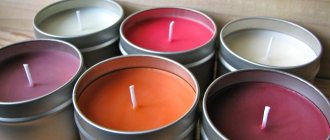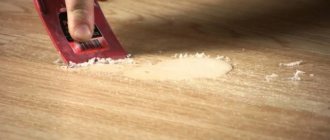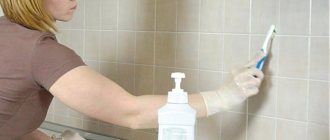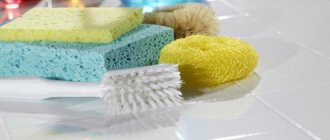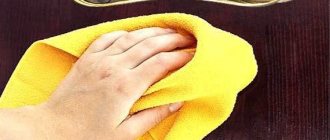It is not very common to encounter stains from wax on dishes in everyday life. However, in the process of making decorative candles at home or performing the depilation procedure yourself, the problem of subsequently eliminating stains of this nature may still arise. Removing wax from dishes is not as simple a task as it might seem at first glance. In order to successfully cope with the task, it is necessary to approach the process as responsibly as possible and at the same time stock up on certain knowledge regarding the intricacies of getting rid of wax contaminants.
Features of removing wax from dishes
In order to remove wax from dishes, you should first determine the nature of the wax material that left an imprint on the household item. In this case, important information regarding the nature of the origin of the substance should be taken into account. In everyday life, the term “wax” is a collective concept, and this is most often the name for one of the following compounds:
- Beeswax . Represents a material of natural, natural origin. The bee product is used in cosmetology and is also widely used in medicine. However, there are several varieties of this natural material, which include: wool wax (lanolin), vegetable wax, fossil wax, etc.
- Paraffin. An artificial material obtained as a result of industrial oil refining. This substance is used in the production of candles and is part of lubricants for equipment.
- Stearin. The artificial material, which is also used in the production and decoration of candles, is actively used in the industrial soap production process and rubber-related industries.
To remove wax from dishes, you need to prepare the following materials in advance:
- an ordinary kitchen knife;
- clean dry soft cloth;
- metal sponge or stiff brush;
- the chosen product to remove wax or paraffin stains.
Depending on the material from which the household utensils affected by wax contamination are made, it is necessary to select a cleaning method that is suitable specifically for it and select the appropriate cleaning component.
In addition, it should be remembered that when cleaning wax from dishes made of crystal, porcelain, glass and other fragile and delicate materials, you should approach the process as responsibly as possible and choose gentle products.
How to remove wax from dishes using traditional methods
In order to remove wax from dishes, you can resort to proven folk methods for solving this problem. Everything you need can always be found in any home, and removing paraffin from dishes only requires some physical effort. At the same time, there is no fundamental difference in what kind of product the household utensils were damaged: wax, paraffin or stearin. The methods for getting rid of contaminants of this nature are identical.
How to remove wax from dishes using heat
There are several basic ways to remove stains from dishes using heat. All of them are very popular and effective, and all that remains is to choose the one that is most convenient for you to use.
Using a hair dryer
To remove a stain using this method, you will need:
- plastic spatula;
- hair dryer;
- clean napkin.
The sequence of actions in order to wash dishes from paraffin will be as follows:
- Using a plastic spatula, you should try to remove most of the contamination by scraping off the remaining substance from the surface of household utensils;
- the remaining spots need to be heated using a hairdryer at the maximum permissible temperature of the device;
- Use a napkin to remove any remaining melted substance from the surface of the dish.
Using steam
This method is considered to be the most gentle and gentle, so it is suitable for removing wax from even the most fragile porcelain and glassware.
For it you will need to prepare:
- container with water;
- clean paper towel or soft, highly absorbent cloth.
Following this algorithm will help you remove wax from glassware:
- heat the water to boiling;
- hold the utensils damaged by paraffin over the steam and wait for it to completely melt;
- Using a napkin or cloth, remove the dirt.
Using an open fire
This method is suitable exclusively for products made from materials that are “not afraid” of exposure to open fire:
It will require:
- any source of open fire (fire, burner, stove);
- paper towel or soft, clean rags;
- heat-resistant tongs.
To clean glass from candle wax, you need to:
- hold household utensils affected by wax contamination directly above an open flame;
- After the paraffin has completely dissolved, remove it using a napkin or cloth.
How to remove paraffin from dishes by degreasing
The technique allows you to quickly and easily deal with paraffin stains. In addition, it is gentle on tableware, so it can be used not only on glass, but also to remove wax from delicate materials such as porcelain or crystal.
For this method you will need:
- container with water;
- any gel-like dishwashing detergent.
In order to remove stains from a product in this way, you must:
- Add dishwashing detergent to a pre-prepared container with water and mix everything thoroughly;
- place household utensils with traces of paraffin into the prepared solution;
- put everything on the fire and wait for it to boil.
Under the influence of high temperature, the substance will melt, and the detergent will not allow it to re-adhere to the already cleaned product.
Types of surfaces and methods for cleaning them
Paraffin and beeswax quickly eat into various surfaces. Therefore, you need to choose methods for removing such stains depending on the location of the contamination.
Type 1. Cleaning the dishes
You can remove wax from dishes (metal, plastic, glass, Teflon) using many available means.
How to remove wax so that there is no trace left on the dishes:
| Image | Instructions |
Recipe 1. Scraping + heating
| |
Recipe 2. Hot water
| |
Recipe 3. Soda
| |
| Recipe 4. Hot steam |
You can wash wax off glass and other fragile materials using a jet of hot steam:
- Boil the kettle and place the required area of the dishes under the stream of steam.
- Then you need to wipe off the melted paraffin with paper napkins.
- Finally, rinse the container in cold water.
This method is only suitable for heat-resistant cookware.
Type 2. Cleaning candlesticks
Cleaning a candle holder from paraffin is quite a difficult task. You need to choose a method based on the material of the stand itself. Let's consider the possible options:
| Recipe 5. Oil You can clean wax that has stuck in a thick layer inside a metal bowl or pan in this way:
|
How to remove wax from dishes using household chemicals
Using a variety of household chemicals will also help remove wax from dishes. The most popular options in this case are:
- Washing powder. In order to get rid of stains in this way, it is necessary to expose wax stains to heat by placing the soiled item under running hot water (temperature at least 50 ° C) after the substance becomes soft. Next, use a sponge and regular washing powder to remove any remaining substance from the surface of the product.
- Liquid for removing dirt from the internal surfaces of ovens and microwave ovens. These products are distinguished by a high alkali content in their composition, so they cope with the task quite easily and quickly. To get the result, you need to apply this product directly to the wax impression and leave everything like that for about 10 minutes. After waiting time, you need to wipe the household item and wash it in the usual way.
- " White Spirit ". It will help to cope with old and heavy paraffin stains. Apply this product to a clean rag and wipe the stains with it. The procedure should be continued until the contamination is completely removed. After this, the product should be washed thoroughly using your usual detergent.
Washing wax crayons
Unplanned traces of wax pencils on wallpaper will make few people happy.
You will have to work hard to get rid of the unplanned “masterpiece” on the wallpaper
- If the wallpaper is washable, you can use rubber glue: apply a thin layer of glue to the pencil drawings, and when it dries, remove the adhesive film along with the remains of wax crayons on the wallpaper.
- On washable wallpaper, you can wipe the patterns with a cloth soaked in mayonnaise, soda slurry, Mr Proper floor cleaner or shaving foam. Leave the product on the contaminated area for a few minutes and then wipe with a damp cloth.
- If the wallpaper is paper, moisten the drawings with wax pencils with gasoline (it is important to ventilate the room well afterwards) or with paint remover from leather. You can also use baby wipes.
And the other day our young Picasso drew on the white walls with an orange and red pencil. I washed it with leather paint remover. (I dye my eyebrows at home, so that there is no dye on the skin, I use it).
Anya
https://www.babyblog.ru/community/post/domovodstvo/1690855
Wet baby wipes. Long, but reliable. They wash everything. Our haggis are blue. I haven't tried others.
Lyulya
https://www.babyblog.ru/community/post/domovodstvo/1690855
To remove crayon marks from your writing board, use baby wipes. You can also use sunflower oil or melamine sponge.
Wax and paraffin - what's the difference?
In most cases, when people think of wax, they think of candles. However, this is not entirely true. Candles are made from paraffin and stearin, but the wax itself is used for cosmetic and medicinal purposes.
Wax can be natural or artificial. It is found in the animal and plant world and is a simple lipid. However, the molecules of the substance, unlike other fats, do not contain glycerol. The substance has low chemical activity, is insoluble in water, but dissolves well in gasoline, ether and chloroform.
Among animal waxes the following stand out:
- bee, secreted by special glands of bees, used by them to build honeycombs;
- wool or otherwise called lanolin, has a protective function, protects the skin and hair of animals from excessive pollution and loss of moisture;
- spermaceti, obtained from sperm whale oil of the same name.
Plant waxes cover a small layer of leaves, fruits and stems of plants, and are included in some seeds. Their main function is to protect against moisture loss, exposure to pathogenic microorganisms, and excessive soaking with water.
A large number of plants are capable of producing so-called epicuticular wax, which can reflect ultraviolet and infrared radiation.
Reference! Jojoba oil, widely used in cosmetic products, is also a natural wax.
Fossil waxes include ozokerite.
The most well-known artificial waxes are paraffin and stearin.
- Paraffin is a wax-like mixture made from petroleum. The substance melts at a temperature of 45-65 degrees, which allows it to be used in the manufacture of candles, food, and cosmetic products.
- Stearin, in turn, is a solid substance that is greasy to the touch. Its melting point is 53-65 degrees.
Wax and paraffin are similar substances in their properties. Therefore, just as you clean dishes from wax, you should do the same with paraffin.
What not to do and why
There are several rules for how to effectively remove paraffin and protect the fabric from damage. Not recommended:
- heat the fabric with a stain of colored wax - the dye will remain on the clothes;
- rub the stain until it dries - this will increase the area of contamination, and the wax will penetrate deeper into the fibers;
- use sharp objects for cleaning - they will damage the surface of the fabric;
- use aggressive solvents for delicate fabrics (if in doubt, it is better to first apply a few drops to an inconspicuous area and observe the reaction).
How to remove wax from dishes
To get rid of substance residues on dishes, in most cases, you can use mechanical methods, for example, scraping with a knife or spatula, and then rinsing. But how to remove wax from dishes on which the use of physical force is unacceptable?
Degreasing and removal
One of the effective ways to remove depilatory wax from dishes without damaging it is to degrease and then remove the substance. The method involves performing the following steps:
- First you need to fill a large saucepan or any other large container with water.
- Then add detergent and stir.
- Place dirty dishes in water and place on the stove.
- After the water boils, the wax will come off on its own, and the detergent will not allow it to stick back.
This method is the most gentle for how to wash dishes from wax, since its use does not require scratching or rubbing the dishes with a knife. Can be used on various surfaces. In this regard, this method is suitable for crystal products, dishes made of porcelain and crystal.
When the wax is colored
The hot iron method is not suitable for colored candles. At high temperatures, the dye is absorbed into the fabric and is almost impossible to remove. To remove colored wax from clothes and tablecloths, it is better to use an industrial stain remover or one of the following methods.
- Leave the item in the cold and scrape off the hardened mass. Treat the trace with borax and then with a mixture of salt and citric acid to remove stains. Rinse off any remaining product with water and wash clothes.
- Treat a stain on a light-colored fabric with hydrogen peroxide or a mixture of soda and citric acid.
- Dense material can be washed with plenty of hot water.
- In such cases, ammonia helps well and does not damage the fabric.
How to wash paraffin?
To quickly deal with the problem of removing wax marks on dishes, tiles, leather and other objects, we recommend several options for products that you probably have on hand. Depending on the type of surface on which the paraffin came into contact, choose the ones that are more convenient for you.
- fire source;
- large container with water;
- plastic knife, card, CD;
- steel wool;
- soda ash;
- dishwashing detergent;
- rag, rags;
- vegetable oil;
- paper napkins, towels, newspapers;
- turpentine;
- alcohol;
- denatured alcohol;
- ice;
- iron;
- hair dryer;
- vacuum cleaner.
How to wash dishes from paraffin?
Most often, candles are placed in different dishes so as not to stain the furniture with dripping drops. Removing wax from dishes is not difficult if you know what methods to use.
Method 1
This option is suitable for plastic, metal, glass and Teflon-coated cookware.
Since paraffin, once on the surface, quickly hardens, you can simply scrape it off:
- Use a plastic object to pick up the edge of the paraffin stain.
- Remove the main part.
- Scrape carefully.
- Use a hair dryer to heat the surface to be cleaned.
- Remove any excess with a paper towel.
Important! Do not use sharp or iron objects when cleaning to avoid damaging the surface.
Method 2
To remove wax from dishes, use hot water:
- Place a container of water on the fire.
- Place paraffin-soaked dishes in it.
- Add detergent.
- Bring to a boil.
- Drain the water.
- Rinse the dishes under hot water.
- Wipe with a cotton rag.
Important! The effect will be greater if you use soda ash instead of detergent.
Method 3
Wash off paraffin stains with baking soda and steel wool:
- Scrape off the main part of the paraffin with a plastic object - a card, a spatula.
- Apply a little baking soda to a washcloth and wipe away any remaining marks.
- Wash the surface under running hot water.
- Polish with dish soap.
- Rinse.
Important! Every housewife from time to time has to solve various household problems, especially in relation to kitchen utensils. Keep in mind a few more useful tips for caring for different utensils:
Method 4
Use hot steam:
- Place a kettle of water on the fire.
- Take a dish contaminated with paraffin or wax and place it under steam.
- Wipe off melted paraffin with paper napkins or towels.
- Repeat the procedure if necessary.
Important! Use this method carefully on glass to prevent it from cracking; dip the item in hot water before exposure to steam.
Useful tips
- Handle hot water carefully to avoid scalding.
- Observe safety precautions when using electrical household appliances.
- When using chemicals, ventilate the room.
- Use personal protective equipment - gloves.
- To avoid irritation and other allergic reactions when removing wax from skin:
- Do not wash off the wax with hot water.
- Do not scrub your skin with a hard washcloth.
- Don't use acetone.
How to remove paraffin from fabric coverings?
To remove paraffin stains from simple, lint-free fabrics, we recommend several options.
Option 1
- Place a pad of several layers of napkins, toilet paper or cotton rag over the stain.
- Heat up the iron.
- Press it onto the gasket; under the influence of high temperature, the paraffin melts and is absorbed into the paper.
- Repeat this step until the gasket is dry.
- After this procedure, a greasy stain will remain on the fabric; to remove it, use laundry soap or concentrated detergent.
- Apply to stain.
- Leave it for some time to take effect.
- Wash in washing machine.
Important! Try not to extend the iron past the edges of the pad.
Option 2
This method excludes the use for synthetic fabrics:
- Place a cotton rag soaked in denatured alcohol under the stain on the wrong side.
- Place a layer of blotting paper on the front side of the stain.
- Iron with a hot iron.
- Change the paper until the grease stain no longer appears on the surface.
- Soak a cotton swab in purified gasoline.
- Blot the grease stain onto the fabric.
- Wash it in a way that suits you
Option 3
If the stain is small:
- Take the item stained with paraffin.
- Place it in a plastic bag.
- Place the bag in the freezer.
- When the paraffin becomes brittle, break it into small pieces.
- Remove with a soft brush.
Option 4
If you have a delicate item, use concentrated dishwashing detergents:
- Apply a thick layer of product to the stain.
- Leave for several hours.
- Wash the item in the washing machine using stain remover powder.
Important! When finishing washing, be sure to take into account the cleaning rules for different materials. The recommendations from our article “What and how to wash clothes from different fabrics?” will help you with this.
On a note
- You can begin removing paraffin only after it has completely hardened. The substance is quickly absorbed and rubbing a fresh stain will cause it to increase. It is best to blot the still hot wax with a napkin.
- For the production of candles, a material with a dense and greasy texture is used. It does not dissolve with water, so regular washing will not remove the wax.
- The longer paraffin remains on the fabric, the deeper it penetrates the fibers and the larger the oil stain will be. Therefore, you need to act quickly.
- The effect of the solvent and stain remover must first be checked on the wrong side or on the waistband so as not to disturb the color or get streaks.
- Often, after removing the wax, a trace of oil is visible on the clothes. You can remove it with known anti-greasy stain products. If the item is dry, then sprinkle the print with talcum powder and leave for half an hour. The powder is shaken off and the contaminated area is washed. Dish gel, vodka or alcohol will successfully remove the stain. All that remains is to wash the item in the usual way.
- White clothes made from natural fibers can be soaked in “Whiteness” to remove candle marks. The area with the imprint on the colored fabric is soaked in vinegar for half an hour. In case of severe contamination, a small amount of citric acid is added to it.
- It is better to remove wax residues from fabric with a toothbrush, because its bristles are the smoothest and do not disturb the structure of the material.
How to remove paraffin from carpet?
The carpet can also be damaged by wax, but drops can be quickly removed using the following methods.
Method 1
The cold will come to your aid. Of course, you can’t put a carpet in the freezer, but use ice as an alternative:
- To avoid getting the carpet wet, place pieces of ice in a plastic bag.
- Apply the bundle to the stain for a while.
- Once the paraffin has hardened, use a heavy object to crush the paraffin into small pieces.
- Brush the carpet with a stiff brush.
- Vacuum.
Method 2
- Clean off paraffin if possible.
- Place several layers of white cotton rag over the stain.
- Cut a hole in a piece of cardboard slightly larger than the spot.
- Place the cardboard on the fabric.
- Apply a hot iron to this structure using pressing movements.
- Make sure that the bottom of the iron does not extend beyond the edges of the cardboard and does not touch the carpet pile.
- Change the fabric until the greasy mark no longer appears.
- Clean with a stiff brush.
Important! Care for carpets in the house must be regular, otherwise the coverings will accumulate dirt, dust, small debris, and also become sources of unpleasant odors. To prevent this from happening and to avoid tiring yourself with time-consuming household chores, check out some simple ways to clean your carpet quickly and effectively.
Removing greasy stains from furniture upholstery and carpets
Often, wax can stain both furniture upholstery and carpet.
Cleaning furniture upholstery
The upholstery of armchairs and sofas is tapestries, acetate, plush, velor, velvet. Stains from soft fleecy fabrics can be removed with heated alcohol or turpentine, they dissolve the wax. Dip a cotton pad in alcohol and apply it to the wax stain for half an hour. Then we treat the stain with soapy water and remove any remaining moisture with a dry cloth.
The fabric upholstery of the sofa can be cleaned of traces of wax with alcohol or turpentine.
If the furniture upholstery is very dirty, this method will help:
- Remove furniture covers.
- Place a dry, clean towel on the inside - preferably a waffle one, folded in several layers, with blotting paper on the outside.
- Iron the stain through the blotter until the towel has completely absorbed the melted paraffin or wax.
Blotting paper is used to absorb grease left on furniture after brushing off wax.
Keep in mind that velor or velvet do not like ironing, so it is better to use alcohol or turpentine, or you can use a paste of soda, which is then washed off with a damp sponge.
Remove paraffin or wax from the pile
Pile fabrics, carpets and rugs are also susceptible to wax contamination - we save them with a hairdryer and a stiff brush (the method is described above), an iron and blotting paper.
Wax from carpet is easy to remove
There is a unique way to clean products with long pile:
- Place a piece of cloth on the wax stain that can absorb moisture and grease well, no smaller than the size of the stain.
- Take a sheet of thick paper, which should be larger than the base of the iron so that the iron does not come into contact with the carpet pile. Place the sheet on the fabric.
- We set the required iron mode - synthetic. Place the iron on top of the paper for a few seconds and iron the stain with it.
Do not extend the iron beyond the edges of the paper, avoiding contact with the lint
- We remove the iron, paper and fabric.
The “cold” method, applied to wax on a fleecy surface of ice, also works. We do not exclude cleaning with hot water, solvent or soap solution.
Ice will easily remove wax residue from the carpet.
Video: how to remove wax drops and wax stains at home
How to remove wax from skin?
If you decide not to use the services of a beauty salon, but to do hair removal yourself, be prepared for the fact that wax marks will remain on your skin after the procedure. What to do in this case?
Method 1
- Soak a cotton swab in vegetable or cosmetic oil.
- Rub the stained area until all traces of wax are completely removed.
Method 2
Alternatively, cosmetic milk or cream will come to your aid:
- Apply the product to the stained area.
- Leave it for a while.
- Use a cotton swab to remove any remaining wax.
- Rinse off with warm water.
Boiling water and hot steam
Not every housewife knows how to wash dishes if there is no detergent. You can remove paraffin from dishes using boiling water or hot steam. The cleaning process consists of several simple steps:
- We put water in a kettle or pan and wait for it to boil;
- We place the contaminated dishes over the steam, the hot fumes should act on the areas with wax;
- At the final stage of work, wipe off the remaining substance with a soft cloth or napkin.
The wax is wiped off in the initial phase of its melting. To completely clean surfaces, you need to use several wipes. When working with glass products, the dishes must first be soaked in hot water to prevent cracks from appearing on them as a result of exposure to steam. Be careful when performing such operations; careless handling of utensils can lead to burns to exposed areas of the body.
